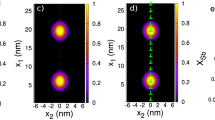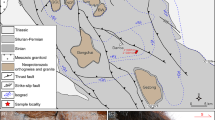Abstract
We have investigated grain boundary diffusion rates in enstatite by heating single crystals of quartz packed in powdered San Carlos olivine (Mg0.90Fe0.10)2SiO4 at controlled oxygen fugacities in the range 10−5.7 to 10−8.7 atm and temperatures from 1350° to 1450 °C for times from 5 to 100 h at 1 atm total pressure. Following the experiments, the thickness of the coherent polycrystalline reaction rim of pyroxene that had formed between the quartz and olivine was measured using backscatter scanning imaging in the electron microprobe. Quantitative microprobe analysis indicated that the composition of this reaction phase is (Mg0.92Fe0.08)2Si2O6. The rate of growth of the pyroxene increases with increasing temperature, is independent of the oxygen fugacity, and is consistent with a parabolic rate law, indicating that the growth rate is controlled by ionic diffusion through the pyroxene rim. Microstructural observations and platinum marker experiments suggest that the reaction phase is formed at the olivine-pyroxene interface, and is therefore controlled by the diffusion of silicon and oxygen. The parabolic rate constants determined from the experiments were analyzed in terms of the oxide activity gradient across the rim to yield mean effective diffusivities for the rate-limiting ionic species, assuming bulk transport through the pyroxene layer. These effective diffusivities are faster than the lattice diffusivities for the slowest species (silicon) calculated from creep experiments, but slower than measured lattice diffusivities for oxygen in enstatite. Thus, silicon grain boundary diffusion is most likely to be the rate-limiting process in the growth of the pyroxene rims. Also, as oxygen transport through the pyroxene rims must be faster than silicon transport, diffusion of oxygen along the grain boundaries must be faster than through the lattice. The grain boundary diffusivity for silicon in orthopyroxenite is then given by D¯gbSiδ=(3.3±3.0)×10−9f0.0O2e−400±65/RT m3s−1, where the activation energy for diffusion is in kJ/mol, and δ is the grain boundary width in m. Calculated growth rates for enstatite under these conditions are significantly slower than predicted by an extrapolation from similar experiments performed at 1000 °C under high pressure (hydrous) conditions by Yund and Tullis (1992), perhaps due to water-enhancement of diffusion in their experiments.
Similar content being viewed by others
Author information
Authors and Affiliations
Additional information
Received September 21, 1995/Revised, accepted June 11, 1996
Rights and permissions
About this article
Cite this article
Fisler, D., Mackwell, S. & Petsch, S. Grain boundary diffusion in enstatite. Phys Chem Min 24, 264–273 (1997). https://doi.org/10.1007/s002690050038
Issue Date:
DOI: https://doi.org/10.1007/s002690050038




